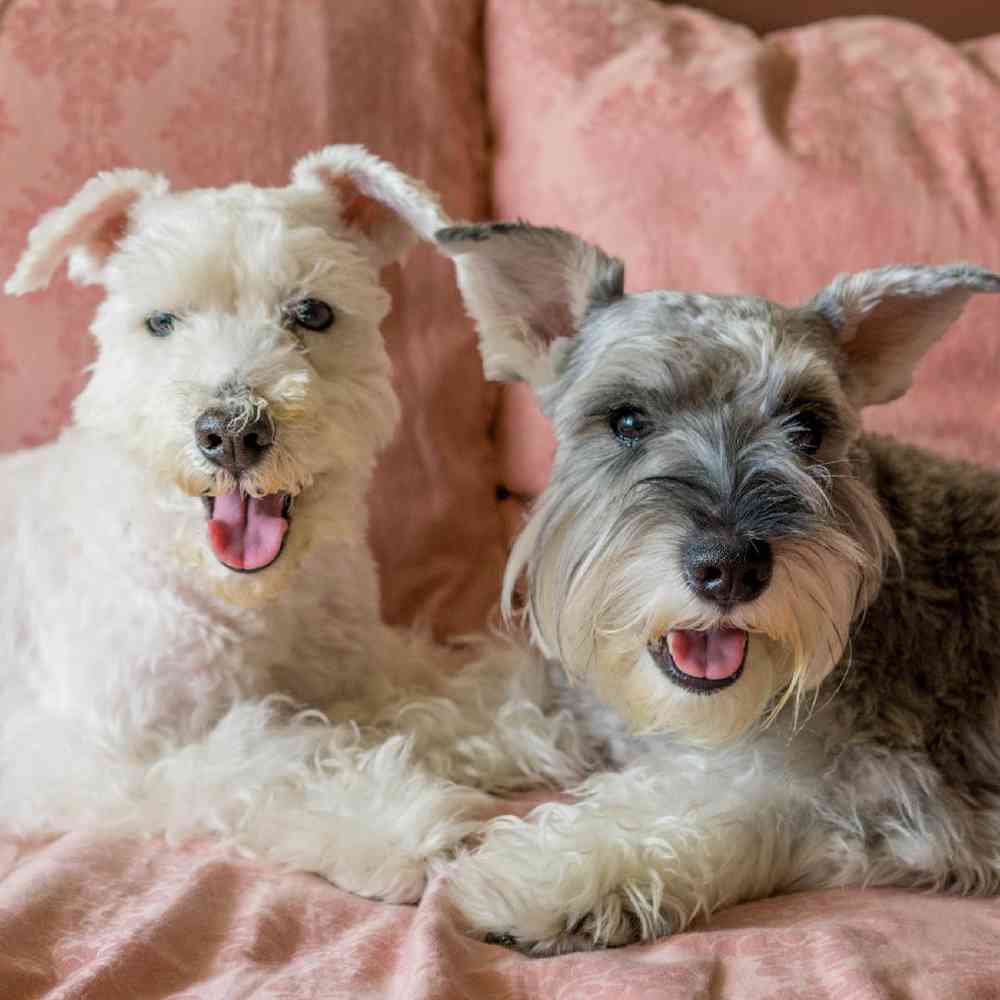
AKC Registrable
Hypo Allergenic
Family Dog
Apartment Friendly
Mini Schnauzer
The Miniature Schnauzer, the smallest of the three Schnauzer breeds, is a generally healthy, long-lived, and low-shedding companion. Add an outgoing personality, a portable size, and sporty good looks, and you’ve got an ideal family dog.
Available Pets
Breed Info
Heritage
The Miniature Schnauzer originated in 19th century Germany, developed from crossing the Standard Schnauzer with the Poodle and Affenpinscher. As a working breed, their job was to rid the property of rats and other small vermin. Today’s Miniature Schnauzers use their skills for hunting, tracking, watchdog, ratting and competitive obedience.
Health Awareness
The Miniature Schnauzer has a life expectancy of 12-15 years and is prone skin disorders, diabetes, kidney stones, liver disease, cysts, and eye disorders.
Personality
The Miniature Schnauzer is a tough, determined, feisty, active, alert watchdog. Highly intelligent, your Miniature Schnauzer will be quick and eager to learn from you. You need to be a calm, knowledgeable, and humane owner giving consistent and committed leadership to your Miniature Schnauzer using only motivational training methods. They are bred to dig, so be ready to give your Miniature Schnauzer a digging pit and teach him or her to use it to keep your flower beds intact. Wary of strangers, you will need to socialize your Miniature Schnauzer, and then socialize more, to prevent any guarding issues from developing. This breed has high prey drive, likes to chase and roam, so a fence is necessary. This amusing, curious, and loving breed is a wonderful little companion.
Additional Information
Grooming Requirements: Requires regular brushing and bathing Coat: Short Shedding: Average shedding Hypoallergenic: No, due to shedding Apartment Living: Good for apartment living if given sufficient exercise Lap Dog: Yes Good With Children: Best with older children who understand how to respect this terrier breed. They do not tolerate rough housing. This breed needs a lot of socialization when a puppy. Good With Other Pets: Good with other dogs when socialized while a puppy; can be scrappy with other dogs; not trustworthy with non-canine pets due to hunting instinct.
Breed Standard
Size, Proportion, Substance
Size - From 12 to 14 inches. He is sturdily built, nearly square in proportion of body length to height with plenty of bone, and without any suggestion of toyishness. Disqualifications - Dogs or bitches under 12 inches or over 14 inches.
Head
Eyes - Small, dark brown and deep-set. They are oval in appearance and keen in expression. Faults - Eyes light and/or large and prominent in appearance. Ears - When cropped, the ears are identical in shape and length, with pointed tips. They are in balance with the head and not exaggerated in length. They are set high on the skull and carried perpendicularly at the inner edges, with as little bell as possible along the outer edges. When uncropped, the ears are small and V-shaped, folding close to the skull. Head strong and rectangular, its width diminishing slightly from ears to eyes, and again to the tip of the nose. The forehead is unwrinkled. The topskull is flat and fairly long. The foreface is parallel to the topskull, with a slight stop, and it is at least as long as the topskull. The muzzle is strong in proportion to the skull; it ends in a moderately blunt manner, with thick whiskers which accentuate the rectangular shape of the head. Faults - Head coarse and cheeky. The teeth meet in a scissors bite. That is, the upper front teeth overlap the lower front teeth in such a manner that the inner surface of the upper incisors barely touches the outer surface of the lower incisors when the mouth is closed. Faults - Bite - Undershot or overshot jaw. Level bite.
Neck, Topline, Body
Neck - strong and well arched, blending into the shoulders, and with the skin fitting tightly at the throat. Body short and deep, with the brisket extending at least to the elbows. Ribs are well sprung and deep, extending well back to a short loin. The underbody does not present a tucked up appearance at the flank. The backline is straight; it declines slightly from the withers to the base of the tail. The withers form the highest point of the body. The overall length from chest to buttocks appears to equal the height at the withers. Faults - Chest too broad or shallow in brisket. Hollow or roach back. Tail set high and carried erect. It is docked only long enough to be clearly visible over the backline of the body when the dog is in proper length of coat. Fault - Tail set too low.
Forequarters
Forelegs are straight and parallel when viewed from all sides. They have strong pasterns and good bone. They are separated by a fairly deep brisket which precludes a pinched front. The elbows are close, and the ribs spread gradually from the first rib so as to allow space for the elbows to move close to the body. Fault - Loose elbows. The sloping shoulders are muscled, yet flat and clean. They are well laid back, so that from the side the tips of the shoulder blades are in a nearly vertical line above the elbow. The tips of the blades are placed closely together. They slope forward and downward at an angulation which permits the maximum forward extension of the forelegs without binding or effort. Both the shoulder blades and upper arms are long, permitting depth of chest at the brisket. Feet-- short and round (cat feet) with thick, black pads. The toes are arched and compact.
Hindquarters
The hindquarters have strong-muscled, slanting thighs. They are well bent at the stifles. There is sufficient angulation so that, in stance, the hocks extend beyond the tail. The hindquarters never appear overbuilt or higher than the shoulders. The rear pasterns are short and, in stance, perpendicular to the ground and, when viewed from the rear, are parallel to each other. Faults - Sickle hocks, cow hocks, open hocks or bowed hindquarters.
Coat
Double, with hard, wiry, outer coat and close undercoat. The head, neck, ears, chest, tail, and body coat must be plucked. When in show condition, the body coat should be of sufficient length to determine texture. Close covering on neck, ears and skull. Furnishings are fairly thick but not silky. Faults - Coat too soft or too smooth and slick in appearance.
Color
The recognized colors are salt and pepper, black and silver and solid black. All colors have uniform skin pigmentation, i.e. no white or pink skin patches shall appear anywhere on the dog. Salt and Pepper - The typical salt and pepper color of the topcoat results from the combination of black and white banded hairs and solid black and white unbanded hairs, with the banded hairs predominating. Acceptable are all shades of salt and pepper, from light to dark mixtures with tan shadings permissible in the banded or unbanded hair of the topcoat. In salt and pepper dogs, the salt and pepper mixture fades out to light gray or silver white in the eyebrows, whiskers, cheeks, under throat, inside ears, across chest, under tail, leg furnishings, and inside hind legs. It may or may not also fade out on the underbody. However, if so, the lighter underbody hair is not to rise higher on the sides of the body than the front elbows. Black and Silver - The black and silver generally follows the same pattern as the salt and pepper. The entire salt and pepper section must be black. The black color in the topcoat of the black and silver is a true rich color with black undercoat. The stripped portion is free from any fading or brown tinge and the underbody should be dark. Black - Black is the only solid color allowed. Ideally, the black color in the topcoat is a true rich glossy solid color with the undercoat being less intense, a soft matting shade of black. This is natural and should not be penalized in any way. The stripped portion is free from any fading or brown tinge. The scissored and clippered areas have lighter shades of black. A small white spot on the chest is permitted, as is an occasional single white hair elsewhere on the body. Disqualifications - Color solid white or white striping, patching, or spotting on the colored areas of the dog, except for the small white spot permitted on the chest of the black. The body coat color in salt and pepper and black and silver dogs fades out to light gray or silver white under the throat and across the chest. Between them there exists a natural body coat color. Any irregular or connecting blaze or white mark in this section is considered a white patch on the body, which is also a disqualification.
Gait
The trot is the gait at which movement is judged. When approaching, the forelegs, with elbows close to the body, move straight forward, neither too close nor too far apart. Going away, the hind legs are straight and travel in the same planes as the forelegs. Note - It is generally accepted that when a full trot is achieved, the rear legs continue to move in the same planes as the forelegs, but a very slight inward inclination will occur. It begins at the point of the shoulder in front and at the hip joint in the rear. Viewed from the front or rear, the legs are straight from these points to the pads. The degree of inward inclination is almost imperceptible in a Miniature Schnauzer that has correct movement. It does not justify moving close, toeing in, crossing, or moving out at the elbows. Viewed from the side, the forelegs have good reach, while the hind legs have strong drive, with good pickup of hocks. The feet turn neither inward nor outward.
Faults
Single tracking, sidegaiting, paddling in front, or hackney action. Weak rear action.
Disqualifications
Dogs or bitches under 12 inches or over 14 inches. Color solid white or white striping, patching, or spotting on the colored areas of the dog, except for the small white spot permitted on the chest of the black. The body coat color in salt and pepper and black and silver dogs fades out to light gray or silver white under the throat and across the chest. Between them there exists a natural body coat color. Any irregular or connecting blaze or white mark in this section is considered a white patch on the body, which is also a disqualification.
Overview
Group
Terrier
Temperament
Friendly, Smart, Obedient
About
Stocky, robust little dogs standing 12 to 14 inches, Miniature Schnauzers were bred down from their larger cousins, Standard Schnauzers. The bushy beard and eyebrows give Minis a charming, human-like expression. The hard, wiry coat comes in three color patterns: salt and pepper, black and silver, and solid black. Created to be all-around farm dogs and ratters, they are tough, muscular, and fearless without being aggressive. The Miniature Schnauzer is a bright, friendly, trainable companion, small enough to adapt to apartment life but tireless enough to patrol acres of farmland. They get along well with other animals and kids. Minis are sturdy little guys and enjoy vigorous play. Home and family oriented, they make great watchdogs.
History
The breed today known as the Standard Schnauzer, one of Europe’s supreme all-around farm dogs, has a lineage going back to at least the 15th century. Old-time German farmers bred the Standard down to miniature size, the better to work as fearless barnyard ratters. With his rat-dog background, the Miniature Schnauzer resides in the AKC Terrier Group with other diminutive rat-catcher breeds. But the Mini is unique among AKC terriers in that he has no British blood in his veins. The vast majority of the terrier breeds were developed in the British Isles. The few created outside of Britain—the Rat Terrier or the Cesky Terrier, for instance—were created with crosses to existing British breeds. Alone among terriers, the Miniature Schnauzer is wholly a product of Continental stock: Standard Schnauzer, Affenpinscher, and Poodle. This explains that though the Mini was born to the traditional work of small terriers, his personality is quite different. Not for him is the dour independence of the Scottish Terrier or the fiery temperament of the Irish Terrier. Rather, he is an overtly friendly dog, spirited but obedient and willing to please. For the most part, the Miniature Schnauzer’s ratting days are long behind him. Today, he is best known as a charming and attractive companion, and a steady winner at dog shows here and abroad. Of the three Schnauzer breeds, the Miniature ranks consistently highest in AKC registrations.
Standard
The Miniature Schnauzer is a robust, active dog of terrier type, resembling his larger cousin, the Standard Schnauzer, in general appearance, and of an alert, active disposition. Faults – Type – Toyishness, ranginess or coarseness.
Nutrition
The Miniature Schnauzer should do well on a high-quality dog food, whether commercially manufactured or home-prepared with your veterinarian’s supervision and approval. Any diet should be appropriate to the dog’s age (puppy, adult, or senior). Some dogs are prone to getting overweight, so watch your dog’s calorie consumption and weight level. Treats can be an important aid in training, but giving too many can cause obesity. Learn about which human foods are safe for dogs, and which are not. Check with your vet if you have any concerns about your dog’s weight or diet. Clean, fresh water should be available at all times.
Grooming
The Miniature Schnauzer has a double coat—a wiry topcoat, with a soft undercoat—that requires frequent brushing, combing, and grooming to look its best. The breed sheds very little. For the show ring, some of the dog’s coat is regularly “stripped” by hand. Most owners of pet Miniature Schnauzers choose to have the coat trimmed with clippers by a professional groomer. This should be done every five to eight weeks for the dog to look his best. The Miniature Schnauzer should get a bath once a month or so, depending on his surroundings. Nails should be trimmed monthly and ears checked weekly for debris or excess wax, and cleaned as needed.
Exercise
Alert and lively, Miniature Schnauzers require regular daily exercise to maintain their mental and physical health. They have a medium energy level and can easily adapt to city or country living. The breed benefits from having a fenced area where they can run and chase a ball safely and enjoy playtime with their owner. Their greatest joy is to be with their family and doing activities together. Miniature Schnauzers have a strong prey drive, so they should never be allowed off leash when not in a fenced area, as they might not resist the urge to chase after small animals.
Training
Miniature Schnauzers are friendly, lively, and eager to please, and they learn quickly. The breed’s high intelligence makes it necessary to keep training fun and interesting, as they can get bored with repetition. They should be socialized from an early age, and both dog and owner benefit from puppy training classes as well. The Miniature Schnauzer makes an excellent companion and can do very well in a number of canine sports, including agility, obedience, rally, and earthdog events.
Health
The Miniature Schnauzer is generally a healthy breed. There are a few conditions that the breed can be prone to, including cataracts, hyperlipidemia, pancreatitis, liver shunts, and urinary stones. Responsible breeders will have breeding stock tested for health issues that can affect the breed. Owners should keep tabs on their dog’s overall condition and consult their vet with any questions or concerns that may arise. Dental care is an important aspect of overall health, and the dog’s teeth should be brushed frequently.
Trivia
Did you know?
Senators Bob and Elizabeth Dole, actress Mary Tyler Moore, actor Bill Cosby, and actor/martial arts expert Bruce Lee have all had Miniature Schnauzers.









